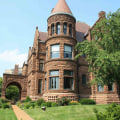St. Louis is a great place for cycling, and the League of American Cyclists has recognized this by awarding the city a bronze rating in its annual Bicycle Friendly Community campaign. Just three Missouri cities: St. Louis, Columbia and Springfield qualified for any classification, with Springfield also receiving a bronze medal and Columbia earning a silver classification.
The need for socially distant transportation systems and health-conscious community transportation systems have inspired an increase in the use of cycling. The Census Bureau reports that cities in the U. S. saw an increase in bicycle traffic after the start of the pandemic, leading to a shortage of bicycles as many Americans discovered that cycling was a relief from isolation at home or a socially distant solution for their trips to work. To find out which cities are the most bike-friendly, we analyzed data from the U.
National Centers for Environmental Information, Walk Score, Rails-to-Trails Conservancy, Vision Zero Network, Google Trends and Yelp. The most bicycle-friendly city in the U. offers 7.7 shared bike stations per 100,000 residents, meaning that biking is increasingly and consistently available to Portland residents. Not only does the city have a busy cycling schedule, but Portland has also invested in several safety measures for pedestrians and bicycles to ensure not only the culture of cycling, but also that the cyclists themselves stay alive, marking the city as a Vision Zero community. Many California cities are in the top 15, but San Francisco takes the cake. Limited to the San Francisco Peninsula, San Francisco is dense but compact, making short trips to work or recreational activities common and perfect for traveling by bicycle.
Consequently, these measures have made it increasingly possible to travel by bicycle. The census reports that 1.7% of San Francisco workers commute to work by bicycle, 236% more than the average city in our study. Today, San Franciscans can easily cycle around the city with a score of 72 out of 100 and 21% more bike trails than the average city we studied (1.7 per 100,000 residents). Because the city recently voted to make Golden Gate Park's JFK Drive permanently car-free, San Francisco has an excellent cycling landscape for cyclists of all ages. Minneapolis has long been home to a vibrant cycling community which in many cases advocates for greater infrastructure and support for bicycles. Among these advocates are groups such as Our Streets Minneapolis and Bicycle Alliance of Minnesota which advocate for more walkable and safe streets and contribute to a community culture that recognizes how bicycle-friendly and walkable cities help promote more accessible spaces, access to jobs and more. Move Minneapolis, a local organization that allows employers to promote alternative methods of transportation provides links to interactive bike maps to help residents plan their trips and the local ABC Ramps Mobility Hub provides lockers, showers and bike racks for everyday commuters and other cyclists. In addition to Vision Zero's commitment to reducing traffic deaths and improving safety measures, the city has done a great job preparing for the 0.7% of workers who cycle every day.
According to the city's website Minneapolis is home to 16 miles of protected bike paths, 98 miles of bike paths and 101 miles of off-street bike trails. From popular routes like the American River Bike Trail to the City College Pedestrian and Bicycle Bridge Sacramento has grown to accommodate new and experienced cyclists. Sacramento which has 2.2 bike trails and 1.5 bike stores per 100,000 residents has invested in numerous projects and infrastructure improvements that make most of the city accessible to people-powered transportation. In addition to city-funded programs local organizations and businesses such as The Sacramento Bicycle Kitchen have continuously supported Sacramento's cycling culture offering courses and repair services and organizing events. Sacramento's cycling community also shows up: Sacramento has a 37% higher average Google Trends score on three different bicycle-related search terms than the average city in our study. Denver's years of support for bicycle safety and accessible micromobility are reflected in its current bicycle fitness score 72% higher than the average for cities in our study. In addition the census reports that 0.8% of Denver workers prepare to bike to work every day. This is great news for Denver cycling advocates such as The Bike Denver Initiative and The Denver Bicycle Lobby who have fought tirelessly for comprehensive public transportation support for bicyclists. With the help of organizations such as The Washington Area Cyclists Association a group that organizes workshops trainings and rides in the neighborhood D. C.
is building safer areas for cyclists and pedestrians. This way events like DC Bike Ride (which is billed as the city's only car-free bike ride) can continue with the support of both people and infrastructure. With 8.2 shared bike stations per 100 000 residents and free passes for eligible essential workers locals can use Bluebikes through Boston's growing network of bike lanes as the city continues to expand through many ongoing bicycle corridor projects. Naturally Seattle is in the top 10 both for number of bike shops per 100 000 inhabitants (1) and for fitness for biking (with a score of 7). And with a clear commitment from Vision Zero to addressing unsafe transit zones and clean air (just three days of poor air quality were reported last year) Seattle is an ideal place for cyclists looking for safe routes. Another family-friendly attraction for beginners is Sunset Greenway in Florissant which connects Sunset Park on The Missouri River with Old Town Florissant on St Francois Street providing access to many historic points of interest located in Old Town. The trailhead is located in St Ferdinand Park north of Interstate 270 & Lindbergh intersection.



